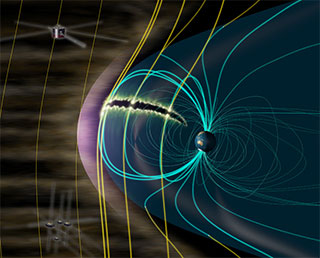Topics List
Nov. 28, 2022 Updated
GEOTAIL ends after over 30 years of observational operations
|
GEOTAIL is a joint Japan-US project to observe the Earth's magnetotail. The satellite was launched in July 1992 from Florida in the USA onboard the Delta-II launch vehicle. On a long elliptical orbit around the Earth, GEOTAIL conducted long-term observations for more than 30 years, and achieved ground-breaking results, in particular numerous discoveries in the Earth's magnetotail, such as demonstrating that magnetic reconnection occurs at the daytime boundary and tail of the Earth's magnetosphere, clarifying how ions and electrons behave in this region. GEOTAIL's operation for more than 30 years far exceeded the originally planned three-and-a-half-year mission period. However, by the end of June 2022, both the satellite's installed data recorders stopped operating. Due to lack of sufficient observation data, it was decided to terminate observation operations on November 28, 2022, and stop the operation of the spacecraft and radiowave transmission. The results of the mission will be summarised by the end of March next year. We would like to express our deepest gratitude to all the organisations and individuals who have cooperating in the operation of GEOTAIL so far. |
Jul. 22, 2016 Updated
The Magnetosphere Has a Large Intake of Solar Wind Energy
|
Solar wind forms the energy source for aurora explosions. How does the Earth’s magnetosphere take in the energy of the solar wind? An international team led by Hiroshi Hasegawa and Naritoshi Kitamura (ISAS/JAXA) analyzed data taken by the US-Japan collaborative mission GEOTAIL and NASA’s MMS satellites and revealed that the interaction between the magnetic fields of Earth and the Sun, or more precisely the phenomenon known as magnetic reconnection, can feed the aurora explosions. |

|
|---|